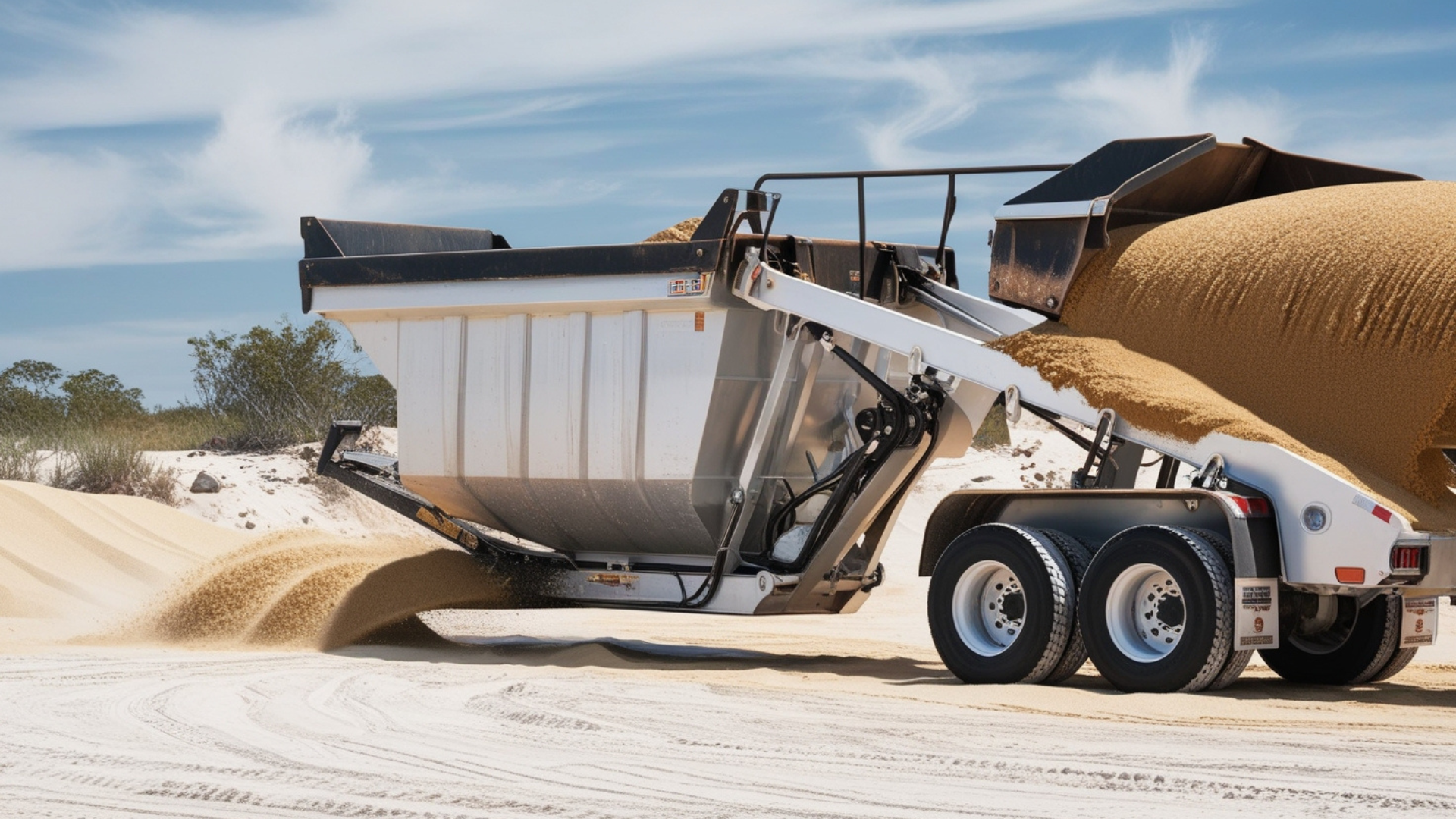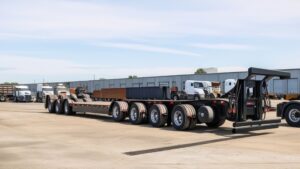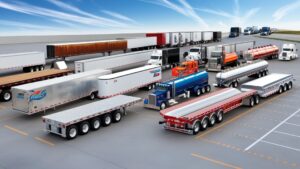Introduction
Design and Architecture
Belly dump trailers are characterized by their distinctive design, featuring a large hopper and a gate at the bottom for discharging materials. This design allows for controlled and efficient unloading, making them highly effective for spreading materials over a wide area.
Key Specifications:
- Chassis: Heavy-duty steel frame
- Hopper Capacity: Typically ranges from 20 to 26 cubic yards
- GVW (Gross Vehicle Weight): Up to 80,000 lbs, depending on the model and configuration
- Dimensions: Length varies, commonly around 40 to 45 feet
- Axle Configuration: 2 to 4 axles, with options for tandem and tri-axle configurations
- Dumping Mechanism: Bottom discharge gates, often air or hydraulically operated
Powertrain and Performance
Belly dump trailers rely on the towing power of trucks they are attached to, usually requiring vehicles with substantial horsepower and torque to handle heavy loads and rough terrain. These trucks are equipped with engines that deliver substantial horsepower and torque, necessary for hauling large quantities of material.
Towing Vehicle Engine Specifications:
- Engine Options: Typically powered by diesel engines from manufacturers like Cummins, Caterpillar, or Detroit Diesel
- Horsepower: Ranges from 350 to 600 hp, depending on the engine model
- Torque: Up to 2,050 lb-ft
- Transmission: Manual or automated manual transmissions (AMTs) with up to 18 speeds
- Fuel Capacity: Dual tanks with a total capacity of up to 200 gallons
The suspension systems in both the towing vehicle and the belly dump trailer itself are designed to provide stability and comfort, even when carrying heavy loads. Options include air-ride suspension and multi-leaf spring suspension, both of which help to reduce driver fatigue and increase safety.
Advanced Features and Technologies
Modern belly dump trailers incorporate a range of advanced features and technologies to enhance performance, safety, and efficiency. These innovations make the trailers more capable and easier to operate, contributing to increased productivity and reduced operational costs.
Key Features:
- Precision Dumping Control: Air or hydraulic actuated gates allow for precise control over material discharge, ensuring even spreading.
- Advanced Braking Systems: Anti-lock braking systems (ABS) and electronic stability control (ESC) enhance safety during operation.
- Telematics and Connectivity: Real-time data on vehicle performance, location, and maintenance needs through integrated telematics systems.
- Durable Construction: Heavy-duty steel construction ensures the trailer can withstand the rigors of transporting heavy and abrasive materials.
- Ergonomic Design: Features like easy-access ladders, well-placed handrails, and spacious hoppers for efficient loading and unloading.
Applications and Uses
The versatility and efficiency of belly dump trailers make them suitable for a wide range of applications across various industries. Here are some of the primary uses:
Construction
In the construction industry, belly dump trailers are invaluable for transporting and spreading materials such as gravel, sand, and asphalt. Their ability to discharge materials evenly over a designated area makes them ideal for road construction, foundation work, and other large-scale projects.
Mining
In mining operations, belly dump trailers are used to transport raw materials such as ore, coal, and aggregates from the extraction site to processing facilities. Their robust construction and high capacity make them well-suited for the demanding conditions of mining environments.
Agriculture
In the agricultural sector, belly dump trailers are utilized for spreading fertilizers, seeds, and other bulk materials over large fields. Their precision dumping capability ensures even distribution, which is crucial for maximizing crop yields.
Municipal Services
Municipal services, such as road maintenance and snow removal, benefit from the efficiency and reliability of belly dump trailers. These trailers can quickly and effectively spread materials like salt, sand, and gravel, helping to maintain safe and navigable roads.
Technological Advancements
Belly dump trailers are equipped with a range of technological advancements that enhance their performance, safety, and efficiency. These innovations ensure that the trailers remain at the forefront of material handling technology.
Advanced Braking Systems
Belly dump trailers feature advanced braking systems, including anti-lock braking systems (ABS) and electronic stability control (ESC). These systems provide superior stopping power and stability, enhancing safety during operation.
Telematics and Fleet Management
Integrated telematics systems provide real-time data on trailer performance, location, and maintenance needs. This technology allows fleet managers to monitor and optimize their operations, ensuring efficiency and reducing downtime.
Precision Load Sensing
Load sensing systems monitor the weight and distribution of the load within the trailer. This technology helps prevent overloading and ensures that the load is evenly distributed, enhancing safety and performance.
Case Studies: Real-World Applications
Road Construction Projects
In road construction projects, belly dump trailers have proven to be invaluable for transporting and spreading materials such as gravel and asphalt. Their precise dumping capability ensures that materials are evenly distributed, which is crucial for creating smooth and durable road surfaces.
Mining Operations
In mining operations, belly dump trailers are used to transport large quantities of raw materials from extraction sites to processing facilities. Their robust construction and high capacity enable them to handle the demanding conditions of mining environments, contributing to increased efficiency and productivity.
Agricultural Applications
In large-scale agricultural operations, belly dump trailers are used to spread fertilizers and seeds over vast fields. Their precision dumping capability ensures even distribution, which is essential for maximizing crop yields and ensuring healthy growth.
Conclusion
Belly dump trailers stand out as essential equipment for efficient material handling in various industries. Their unique design, advanced features, and high capacity make them indispensable for tasks that require precise and efficient transportation and unloading of bulk materials. Whether used in construction, mining, agriculture, or municipal services, belly dump trailers deliver exceptional performance and reliability. As technological advancements continue to shape the future of material handling, belly dump trailers are poised to remain at the forefront, setting new standards for efficiency and versatility in the years to come.




